
- Usage in publication:
-
- Avila member
- Modifications:
-
- Original reference
- Dominant lithology:
-
- Sandstone
- AAPG geologic province:
-
- San Joaquin basin
Summary:
Pg. 7 (fig. 3), 21-24, 41 (App.), pls. 1, 2. Avila member of Serpiente sandstone. Large tongue of concretionary sandstone, 2,710 feet thick; lies between upper and lower portions of Torcido member [informal]. To north, member extends outside mapped area for an undetermined distance; at its southern end, it tapers and pinches out about one-half mile south of Avila Canyon. Age is Late Cretaceous.
Named from occurrence in vicinity of Avila Canyon (local name), Orchard Peak area, Diablo Range, map coords. 1090/1424 (see pl. 1 geol. map), [2+ mi east of Orchard Peak and 5+ mi north of Kecks Corner, in secs. 13 and 14, T. 25 S., R. 17 E., approx. Lat. 35 deg. 45 min. 00 sec. N., Long. 120 deg. 05 min. 42 sec. W., Pyramid Hills and Sawtooth Ridge 7.5-min quadrangles], Kern Co., southern CA. Avila Canyon named for an early settler who lived in the vicinity.
[GNC remark (Jan. 20, 2019): subsequent geologists consider Marsh's stratigraphic classification to be of local significance. Most apply Anderson and Pack's (1915) stratigraphic terminology and assign these rocks to the Panoche Formation. See also Panoche.]
Source: Publication; US geologic names lexicon (USGS Bull. 1200, p. 178).
For more information, please contact Nancy Stamm, Geologic Names Committee Secretary.
Asterisk (*) indicates published by U.S. Geological Survey authors.
"No current usage" (†) implies that a name has been abandoned or has fallen into disuse. Former usage and, if known, replacement name given in parentheses ( ).
Slash (/) indicates name conflicts with nomenclatural guidelines (CSN, 1933; ACSN, 1961, 1970; NACSN, 1983, 2005, 2021). May be explained within brackets ([ ]).

